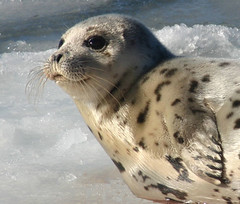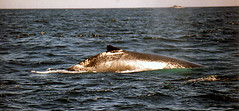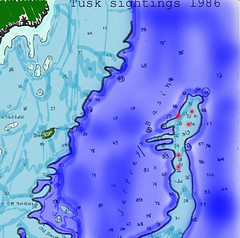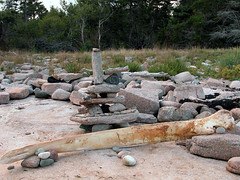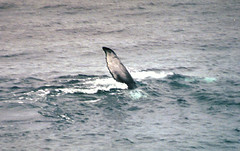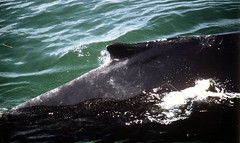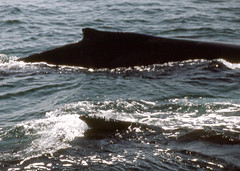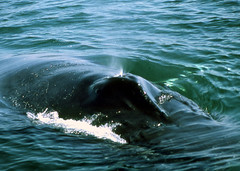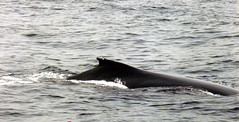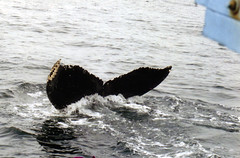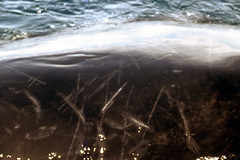I have been heart sick and busy working to prevent the Harp Seal Harvest and so have not written here for a while
The first part of the hunt has been carried out. The second larger hunt will start on April 12th.
These two news sources are from April 4th.
The following articles give a pretty balanced account of the seal "harvests" history and latest news:
theglobeandmail
bbc
Please help stop the "harvest" of 300,000 harp seal pups. Here are some things you can do:
Support the Humane society
Put pressure on the Canadian Government by writing the Bureau of Tourism. Ask how they can possibly promote "ecotourism" (whale watching etc.) while hundreds of thousands of pups are being killed.
The Bureau invites you to contact them please do.
canadatourism
Also Prime Minister Paul Martin has the personal authority to end the seal hunt.
His email address is:
pm@pm.gc.ca
Apparently the price for seal pelts has gone way up since people in Norway, China and Russia consider their fur to be fashionable again. If you have any contact with the "fashion" world could you make your opinions known?
86 8-20 Tusk10
We saw Tusk two or three more times in August, always near mothers and calves and usually moving with great determination and speed (for a humpback). He never paid us any attention. Here he is on 8/20/86. There were at least 8-10 humpbacks in one small area .... the northwest edge of Jeffreys (right near the top "finger"). We could recognize four: Sargent #0281 (a young female), Equus and her calf (Tusk's mother) , Notch (not sure of sex) and Tusk. Tusk was moving fast from one group to another with a energy that seemed very characteristic to him. After a while I found I could recognize Tusk just by his way of moving and his tidy muscular dorsal. It had been stormy for several days previous to this one and the seas were rough so it was hard to get good clear photographs and a lot of passengers were very sea-sick so we couldn't stay long. It was so frustrating to have to leave this very interactive group behind
8/21/86
As you can see, the storm passed and the sea calmed by the next day. We decided to go back to the same area where we had left Tusk the day before. On the way out we passed through areas of the Basin which were obviously rich with life. Shearwaters and petrals were in excited clumps on the surface of the water and we encountered a group of over 100 White-sided Dolphin chasing and leaping with exhuberance. The captain could see on the fishfinder that we passed over many areas dense with schooling fish.
We found many of the same whales on exactly the same spot we had left them the day before. Sargent was there again swiming in tandem with a whale named Cygnus #0294 (a male first seen in 1980). Two Minke whales, three Finbacks and 10 or more Alantic Whitesided dolphins were feeding in the same area weaving in and out of each other. At one point a dolphin began "bowriding" a fast moving Finback, perhaps hooking a ride with it from one group of prey to another. Even though Finbacks eat plankton and small fish and dolphins eat large fish... large fish eat small fish and so the food chain winds into a circle.
Just a bit further on we came upon Tusk was with another whale we did not recognize.
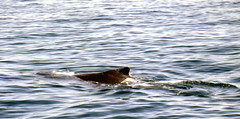
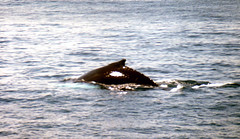
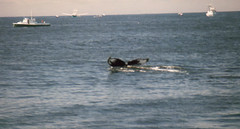
8/21/86
As you can see, the storm passed and the sea calmed by the next day. We decided to go back to the same area where we had left Tusk the day before. On the way out we passed through areas of the Basin which were obviously rich with life. Shearwaters and petrals were in excited clumps on the surface of the water and we encountered a group of over 100 White-sided Dolphin chasing and leaping with exhuberance. The captain could see on the fishfinder that we passed over many areas dense with schooling fish.
We found many of the same whales on exactly the same spot we had left them the day before. Sargent was there again swiming in tandem with a whale named Cygnus #0294 (a male first seen in 1980). Two Minke whales, three Finbacks and 10 or more Alantic Whitesided dolphins were feeding in the same area weaving in and out of each other. At one point a dolphin began "bowriding" a fast moving Finback, perhaps hooking a ride with it from one group of prey to another. Even though Finbacks eat plankton and small fish and dolphins eat large fish... large fish eat small fish and so the food chain winds into a circle.
Just a bit further on we came upon Tusk was with another whale we did not recognize.



1986 Tusk second sighting 8/13/86
When you look at the photographs, you can see it was a flat calm, hot day with very little wind and visibility for miles! We started seeing whales as soon as we arrived at the north end of : 3-4 Minkes, 5+ Finbacks and several humpback pairs diving together. There was "bait" (fisherman's term for large concentrations of all kinds of sea creatures on the fish finder) all around us. On the west face of there is an area called the fingers, three segments of the ledge that point to the west, here the ledge rises sharply and nutrients from the bottom are swept up by the tides. Fishermen and whales find lots of food here.
First we came on a calf with two adults. One turned out to be FiveJ #0104, known to have a calf that year and the other an accompanying adult. We were curious what the relationship was between FiveJ and this other adult... Was it a male escort (seemed a little early), a sibling of the calf (we couldn't tell since it didn't fluke). FiveJ is on the right diving deeply, the calf is close by her on the left. FiveJ has a very black fluke and there are several other whales with black flukes (probably 200-300!) so the only way to determine this is FiveJ is by carefully following the trailing edge of her fluke which looks like it has been cut with a one of a kind pair of pinking shears.... each whale has a distinct trailing edge but it is not so important on a whale with a distinctly marked tail.
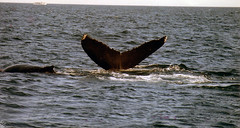
We didn't even have to move the boat, we just drifted with the tide to the next whale which was Fringe #0159, another mother with her calf. As we were arrived the calf breached once, but it was so unexpected that no one caught it on film. Sometimes it is a blessing when that happens, allowing the experience to enter directly into your eyes and heart without glass and technology filtering it. We moved slowly along with Fringe and her calf even though there were several 3-4 Minkes, at least 2 Finbacks and as many Humpbacks all around us.
Fringe was huge! Females tend to be larger than males and she was impressive the largest Humpback I had ever seen. Fringe had been seen since 1979 and had a calf in 1979,1982,1984 and this 1986 calf (the first three were determined to be male). Since she was seen so often up and down the Gulf of Maine, a profile of her character developed: she didn't interact with boats much, she tended to be a loner during years without a calf. She also had a unique way of filter feeding with the tip of her nose just sticking out as she plowed along near the surface. Her 1979 son imitated her technique.
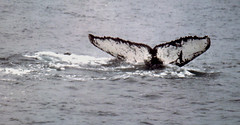
Her dorsal fin was very distinctive and like Talon and, to a lesser degree, Tusk it was possible to identify her before she dove and showed her fluke. This was, most likely, one of the reasons she was so well known.
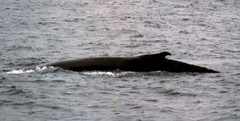
At one point she turned directly towards the boat... it did not have the warm fuzzy feeling of our encounters with Fissure or Talon. It felt more like she was saying "O.K. that's enough". The captain and I had been surprised by how small her calf was and he was being extra careful to start with. Maybe it was a late calf, born in March just before the whales migrated north rather than a normal January or February birth, or maybe it looked small in comparison to its huge mother. But that was all he needed to know he should let her be. If you go on a whale watch pay attention to how the captain works around the whales.... how much respect he or she gives them.
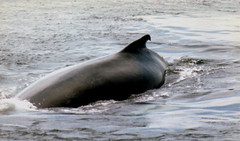
We saw the blow of another whale that was in the direction of home and it was getting pretty late so we headed 3/4 of a mile to the west and there was Tusk, by himself but close enough to the clump of females and their calves that we suspected they were all well aware of each other. Humpbacks sing when they are on the breeding grounds, long elaborate songs that change each year and are thought to be sung only by males. If they are capable of such complex sounds for breeding purposes, something like bird songs, then perhaps they also have short chirping calls like birds that keep groups together. I would look out over the huge expanse of water and see a far off boat. At first I felt completely detached and distant from them, but soon realized that the captain was in contact with them all the time, comparing weather impressions, helping each other find fish or... whales, keeping tabs on each other, gossiping, arguing and wondered if the whales weren't doing something similar.
We stayed with Tusk for a while but he was busy feeding and did not approach us so we figured it was time to head home. As you can see from this picture, when we were done we called over the other whale watch boat and went on our way. We may have been competitors but had a strict code of not crowding a whale with too many boats and would often take turns riding along with a whale.
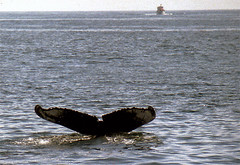
First we came on a calf with two adults. One turned out to be FiveJ #0104, known to have a calf that year and the other an accompanying adult. We were curious what the relationship was between FiveJ and this other adult... Was it a male escort (seemed a little early), a sibling of the calf (we couldn't tell since it didn't fluke). FiveJ is on the right diving deeply, the calf is close by her on the left. FiveJ has a very black fluke and there are several other whales with black flukes (probably 200-300!) so the only way to determine this is FiveJ is by carefully following the trailing edge of her fluke which looks like it has been cut with a one of a kind pair of pinking shears.... each whale has a distinct trailing edge but it is not so important on a whale with a distinctly marked tail.

We didn't even have to move the boat, we just drifted with the tide to the next whale which was Fringe #0159, another mother with her calf. As we were arrived the calf breached once, but it was so unexpected that no one caught it on film. Sometimes it is a blessing when that happens, allowing the experience to enter directly into your eyes and heart without glass and technology filtering it. We moved slowly along with Fringe and her calf even though there were several 3-4 Minkes, at least 2 Finbacks and as many Humpbacks all around us.
Fringe was huge! Females tend to be larger than males and she was impressive the largest Humpback I had ever seen. Fringe had been seen since 1979 and had a calf in 1979,1982,1984 and this 1986 calf (the first three were determined to be male). Since she was seen so often up and down the Gulf of Maine, a profile of her character developed: she didn't interact with boats much, she tended to be a loner during years without a calf. She also had a unique way of filter feeding with the tip of her nose just sticking out as she plowed along near the surface. Her 1979 son imitated her technique.

Her dorsal fin was very distinctive and like Talon and, to a lesser degree, Tusk it was possible to identify her before she dove and showed her fluke. This was, most likely, one of the reasons she was so well known.

At one point she turned directly towards the boat... it did not have the warm fuzzy feeling of our encounters with Fissure or Talon. It felt more like she was saying "O.K. that's enough". The captain and I had been surprised by how small her calf was and he was being extra careful to start with. Maybe it was a late calf, born in March just before the whales migrated north rather than a normal January or February birth, or maybe it looked small in comparison to its huge mother. But that was all he needed to know he should let her be. If you go on a whale watch pay attention to how the captain works around the whales.... how much respect he or she gives them.

We saw the blow of another whale that was in the direction of home and it was getting pretty late so we headed 3/4 of a mile to the west and there was Tusk, by himself but close enough to the clump of females and their calves that we suspected they were all well aware of each other. Humpbacks sing when they are on the breeding grounds, long elaborate songs that change each year and are thought to be sung only by males. If they are capable of such complex sounds for breeding purposes, something like bird songs, then perhaps they also have short chirping calls like birds that keep groups together. I would look out over the huge expanse of water and see a far off boat. At first I felt completely detached and distant from them, but soon realized that the captain was in contact with them all the time, comparing weather impressions, helping each other find fish or... whales, keeping tabs on each other, gossiping, arguing and wondered if the whales weren't doing something similar.
We stayed with Tusk for a while but he was busy feeding and did not approach us so we figured it was time to head home. As you can see from this picture, when we were done we called over the other whale watch boat and went on our way. We may have been competitors but had a strict code of not crowding a whale with too many boats and would often take turns riding along with a whale.

1986 First sighting of Tusk01 7/1/86 #1
It was a perfect day: calm, clear, a slight breeze the air temperature 73º. The water was still a cold 55º but that is the Gulf of Maine for you, it rarely gets above the low 60's. The cold temperature contributes to the richness of life in the Gulf of Maine, since cold water holds more oxygen allowing the food chain to flourish.
As we crossed the deeper water of Jeffrey's Basin we came upon large groups of Atlantic Whitesided Dolphin. Clumps would break off the larger group and race along, wheeling around us. There were very small ones hugging tight to the side of large adults (their moms). As we travelled along more and more came close to the boat, swooping in from right angles and bowriding. Some would turn on their sides and look right up at us, some would weave back and forth around each other jockeying for the position where the pressure wave had the greatest effect, at times slapping their tails without losing any ground. We were going close to 18 knots, fast for our loaded and solid old boat.... but whenever they chose they could accelerate and leave us in their wake.
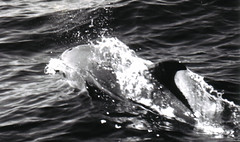
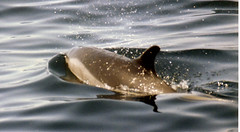
These dolphin were headed in the same general direction we were and when we came upon our first humpback Flask (a mature female with a white fluke), the dolphins were running energetic circles around us and Flask. We were seeing lots of evidence of plankton and fish on the fish sonar. Sometimes the filter feeding whales would be eating the plankton or small easily filtered critters like sandlance or herring in the company of larger fish and the dolphin would be feeding on the larger fish. If the seas were calm you could see all these different critters flitting to the surface to escape predators from below only to be a the mercy of seabirds from above.
As we neared Jeffrey's ledge we could see at least 6 humpbacks in pairs. From their dive patterns it looked like they were feeding and perhaps had paired off to feed cooperatively. We drifted close to this pair

The whale on the right would bunch up its tail ready for a deep dive but then slip under without ever showing his fluke. We watched them through 4 dive cycles where they would be down for 2-3 minutes, come up and blow one or two times then dive again. Some people thought they saw either a line (rope) or a white scar on its tail stock and we worried it might be entangled, though we never confirmed it. The other fluked each of the 4 time and when I got hope I checked my whale catalogue and found out it was Tusk.
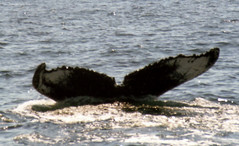
They were always very close together, so close that at one point they bumped each other as the switched sides, one diving over the top of the other.
As we crossed the deeper water of Jeffrey's Basin we came upon large groups of Atlantic Whitesided Dolphin. Clumps would break off the larger group and race along, wheeling around us. There were very small ones hugging tight to the side of large adults (their moms). As we travelled along more and more came close to the boat, swooping in from right angles and bowriding. Some would turn on their sides and look right up at us, some would weave back and forth around each other jockeying for the position where the pressure wave had the greatest effect, at times slapping their tails without losing any ground. We were going close to 18 knots, fast for our loaded and solid old boat.... but whenever they chose they could accelerate and leave us in their wake.


These dolphin were headed in the same general direction we were and when we came upon our first humpback Flask (a mature female with a white fluke), the dolphins were running energetic circles around us and Flask. We were seeing lots of evidence of plankton and fish on the fish sonar. Sometimes the filter feeding whales would be eating the plankton or small easily filtered critters like sandlance or herring in the company of larger fish and the dolphin would be feeding on the larger fish. If the seas were calm you could see all these different critters flitting to the surface to escape predators from below only to be a the mercy of seabirds from above.
As we neared Jeffrey's ledge we could see at least 6 humpbacks in pairs. From their dive patterns it looked like they were feeding and perhaps had paired off to feed cooperatively. We drifted close to this pair

The whale on the right would bunch up its tail ready for a deep dive but then slip under without ever showing his fluke. We watched them through 4 dive cycles where they would be down for 2-3 minutes, come up and blow one or two times then dive again. Some people thought they saw either a line (rope) or a white scar on its tail stock and we worried it might be entangled, though we never confirmed it. The other fluked each of the 4 time and when I got hope I checked my whale catalogue and found out it was Tusk.

They were always very close together, so close that at one point they bumped each other as the switched sides, one diving over the top of the other.
86 7-1 Tusk01
Originally uploaded by yeimaya.
Originally uploaded by yeimaya.
Tusk sightings 1986
End of Talon's Story
Talon's story did not have a happy ending. During the winter of 1987-1988 one humpback after another washed ashore, many of them on Cape Cod. By January 14 were found: Talon was one of them and Beltane another. It was a horrible two months for me it must have been a nightmare for researchers who had know these whales since they were born.
Talon's calf was seen the next summer in the Gulf of Maine so at least he survived for through the winter and following spring without her.
It was not certain what had caused so many deaths during the fall and winter. Some whales were fresh enough to autopsy and herring with high concentrations of red tide in their livers were found in the whale stomach.
Talon may have fed on those herring too in effort to regain her body fat from a summer of nursing a hungry calf. She would need it for the long migration to the Carribean and lean winter there without feeding.
This photograph is not of Talon but of a female that died only 2 years ago. Many whales were found floating at sea and a few came ashore. Their bodies were so decayed that the cause of death could not be determined, but red tide was a primary suspect.
Red tide is naturally occuring but it particularl thrives on pollution we release into the ocean from our rivers. As well as feeling enormous sadness for the loss of these whales (some of them "friends"), I also feel responsible to them. I hope by telling their story that I can encourage people to get involved in protecting and restoring our oceans.
Talon's calf was seen the next summer in the Gulf of Maine so at least he survived for through the winter and following spring without her.
It was not certain what had caused so many deaths during the fall and winter. Some whales were fresh enough to autopsy and herring with high concentrations of red tide in their livers were found in the whale stomach.
Talon may have fed on those herring too in effort to regain her body fat from a summer of nursing a hungry calf. She would need it for the long migration to the Carribean and lean winter there without feeding.
This photograph is not of Talon but of a female that died only 2 years ago. Many whales were found floating at sea and a few came ashore. Their bodies were so decayed that the cause of death could not be determined, but red tide was a primary suspect.
Red tide is naturally occuring but it particularl thrives on pollution we release into the ocean from our rivers. As well as feeling enormous sadness for the loss of these whales (some of them "friends"), I also feel responsible to them. I hope by telling their story that I can encourage people to get involved in protecting and restoring our oceans.
1987 Second sighting of Talon 8/10/87 #3
Forty five minutes later Talon and her calf finally arrived and joined the gang. The calf immediately settled into to rolling and flipperslapping.
Our boat could go 10 knots easily (18 with some serious strain) while a humpback can't move much more than 4 knots. With her calf in tow, I am sure Talon could only poke along. So it wasn't surprising it had taken so long.
All the while we had been watching Beltane, Tusk and Silver, another whale breached repeatedly not far off. We wondered if that had drawn Talon to this group.
This had been a very busy trip. There was lots to watch but no close encounters since the whales were busy with their own social interactions. When Talon dove and we were sure of the locations of her calf, we left the with lots to process on the way home.
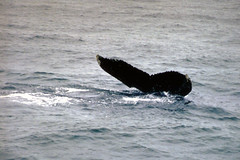
It was the last time I was to see her.
Our boat could go 10 knots easily (18 with some serious strain) while a humpback can't move much more than 4 knots. With her calf in tow, I am sure Talon could only poke along. So it wasn't surprising it had taken so long.
All the while we had been watching Beltane, Tusk and Silver, another whale breached repeatedly not far off. We wondered if that had drawn Talon to this group.
This had been a very busy trip. There was lots to watch but no close encounters since the whales were busy with their own social interactions. When Talon dove and we were sure of the locations of her calf, we left the with lots to process on the way home.

It was the last time I was to see her.
1987 Second sighting of Talon 8/10/87 #2
We left Talon and her calf behind as we moved north towards the other humpbacks, but watching off our stern, I could see that they were coming along slowly behind us. When we arrived we found a fascinating congregation of four whales. First there was Tusk and Beltane who were close together breathing and diving in sync. Both whales were young adults (the same generation as Talon).
Tusk was male and had been see as a calf with his mother Equus in 1979 making him an eight year old that year. He seemed to think of himself anyway as a fully mature male, even though eight seemed young to take on the older males.

Beltane was a female who had been born in 1980, she had had a calf in 1985 (young for a whale). Twice, Tusk broke away from Beltane and dove under our boat from bow to stern. It was hard to determines what he was doing but it seemed like he was asserting territory at the very least.... we stood back at a respectable distance.
[Beltane's fluke shot coming soon]
It is not clear why Tusk and Beltane were together. North Atlantic Humpbacks are thought to mate in the Caribbean, that is where males sing their beautiful songs. Were these two engaged in some sort of foreplay?
Another very interesting association came to ligt when I got home, sorted out all the fluke shots and called Allied Whale to get background information about the whales we saw that day. A very distinctive whale (it was missing a good part of its left fluke), hanging out nearby in the company of a forth whale (who never fluked) turned out to be Silver, Beltane's mother!
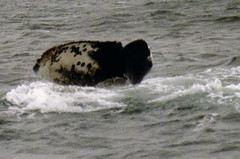
These pictures were taken of Silver on 10/1/87 the last trip of the season when she was most likely headed south for the winter. She was obviously full of vigor, even seemed to be enjoying the turmoluous seas.... a whole lot more than some people on the boat.
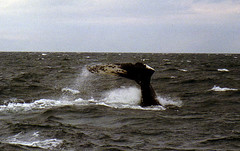
And here she is slipping under the surface of the water where it was much calmer.
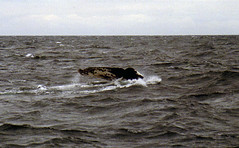
Tusk was male and had been see as a calf with his mother Equus in 1979 making him an eight year old that year. He seemed to think of himself anyway as a fully mature male, even though eight seemed young to take on the older males.

Beltane was a female who had been born in 1980, she had had a calf in 1985 (young for a whale). Twice, Tusk broke away from Beltane and dove under our boat from bow to stern. It was hard to determines what he was doing but it seemed like he was asserting territory at the very least.... we stood back at a respectable distance.
[Beltane's fluke shot coming soon]
It is not clear why Tusk and Beltane were together. North Atlantic Humpbacks are thought to mate in the Caribbean, that is where males sing their beautiful songs. Were these two engaged in some sort of foreplay?
Another very interesting association came to ligt when I got home, sorted out all the fluke shots and called Allied Whale to get background information about the whales we saw that day. A very distinctive whale (it was missing a good part of its left fluke), hanging out nearby in the company of a forth whale (who never fluked) turned out to be Silver, Beltane's mother!

These pictures were taken of Silver on 10/1/87 the last trip of the season when she was most likely headed south for the winter. She was obviously full of vigor, even seemed to be enjoying the turmoluous seas.... a whole lot more than some people on the boat.

And here she is slipping under the surface of the water where it was much calmer.

1987 Second Meeting with Talon 8/10/87 #1
The twenty miles from Kennebunkport out to Jeffrey's ledge was always a long trip, especially on a day like this when there was a big ocean swell leftover from weather the previous day. People were full of anticipation and that helped to distract them from any queasiness they may be feeling but other distractions were always welcome. It was unusual to find baleen whales when we traveled across the "basin" because they needed large clumps of krill, copepods, sandlaunce, herring... the tiny critters that were most usually found on the ledge itself. But it was the height of summer and the ocean was in "full bloom". We had been seeing patches sandlance near the surface and on the feed finding sonar all the way across the basin so it wasn't that surprising to encounter a Minke whale a couple of miles west of "the fingers" (click on the map for a larger labeled version).
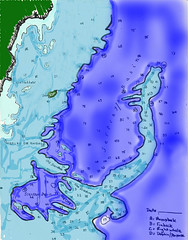
Just as soon as we came on "the fingers", things got very busy and people started feeling fine, all sea-sickness forgotten! Right away we saw blows. They were the short bushy blows of a humpback, as opposed to the finback's blow which is tall and straight like smoke coming out of a chimney. When we got closer we saw this strange sight, some people were convinced it was a huge shark swimming at the surface of the water!
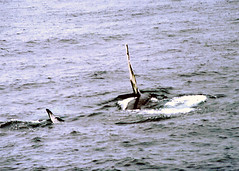
But we soon saw Talon and figured out it was her calf, lieing on its side with one fluke sticking out and its flipper waving in the air. We hadn't seen her since the wonderful encounter on June 20th. Once again the calf was the interactive one while Talon hovered in the background.... quite some change from her calfhood when she was the clowning center of attention. She seemed to be taking her mothering role very seriously.
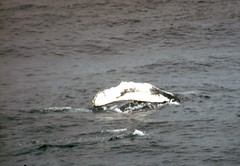
We moved off to insure they weren't overwhelmed, heading north ourselves since we saw the blows of a finback and more humpbacks in that direction.

Just as soon as we came on "the fingers", things got very busy and people started feeling fine, all sea-sickness forgotten! Right away we saw blows. They were the short bushy blows of a humpback, as opposed to the finback's blow which is tall and straight like smoke coming out of a chimney. When we got closer we saw this strange sight, some people were convinced it was a huge shark swimming at the surface of the water!

But we soon saw Talon and figured out it was her calf, lieing on its side with one fluke sticking out and its flipper waving in the air. We hadn't seen her since the wonderful encounter on June 20th. Once again the calf was the interactive one while Talon hovered in the background.... quite some change from her calfhood when she was the clowning center of attention. She seemed to be taking her mothering role very seriously.

87 8-10 Taloncalf01
Originally uploaded by yeimaya.
The calf was at the surface a lot, rolling around alone at first, then traveling with her mom slowly but methodically towards the north. When the other whale watch boat came up to join us, Talon and the calf just dove underneath, without "breaking their stride" and kept right on going.Originally uploaded by yeimaya.
We moved off to insure they weren't overwhelmed, heading north ourselves since we saw the blows of a finback and more humpbacks in that direction.
1987 First meeting with Talon 6/20/87 #4
The calf found us fascinating, and in close company with its mother, Talon, it circled us many times. The encounter lasted two hours. There was so much going on that I just put down my camera and watched. I did manage to get some sketchy notes:
"1434 (2:34 p.m.) both whales come up close together near our bow. The calf "wags" its fluke, slashing back and forth just below the surface of the water. Then they do a deep dive side by side. Talon "flukes up" but the calf didn't fluke enough to get a good picture. Is it still too young, bouyant and weak to dive deeply?
1438 the calf pops up again and blows, then lies just below the surface of the water for 7 minutes. Everybody is totally silent and fascinated as they watch.
1445 the calf comes up to blow and sinks back down again.
1450 both Talon and the calf are up briefly, blow a couple of times and dive again this time both bring up their flukes. (I just watched, my camera on the other side of the boat, rats).
1450-1458 the two are down for eight minutes then come up very close to the port side of the boat.
1500-1550 The calf stays just below the surface where we can easily see it or it comes up and circles us. It tailwags repeatedly and each time the passengers cheer. Then it lies perpendicular to us, almost touching the boat with its nose (rostrum). It drifts slowly around the boat rolling on its side showing a fluke, thus giving us a "mug shot" that can be used in the Humpback whale catalog to identify it in the future. We clearly see its eye as it looks up at us. (It is always breathtaking and moving to be caught in a whale's gaze.)
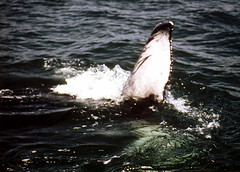
All the while, Talon's dark shape, like a huge shadow drifts along just beneath the calf. The two dive under the boat and come up on the other side three times, causing us to stampede across following them. People become self conscious, laughing at themselves and wondering both what we sound like to the two whales under the water, and if they are diving back and forth to repeat the effect."
Finally they seemed they get bored, dove deep off our stern and headed away. The captain never followed a whale when it chose to leave us.... he valued their privacy very highly and did everything possible to protect it. This is one sign of a good captain, another is that he or she will not approach whales any closer than the prescribed distance, rather, they will stop outside that distance and wait for the whales to approach them.
"1434 (2:34 p.m.) both whales come up close together near our bow. The calf "wags" its fluke, slashing back and forth just below the surface of the water. Then they do a deep dive side by side. Talon "flukes up" but the calf didn't fluke enough to get a good picture. Is it still too young, bouyant and weak to dive deeply?
1438 the calf pops up again and blows, then lies just below the surface of the water for 7 minutes. Everybody is totally silent and fascinated as they watch.
1445 the calf comes up to blow and sinks back down again.
1450 both Talon and the calf are up briefly, blow a couple of times and dive again this time both bring up their flukes. (I just watched, my camera on the other side of the boat, rats).
1450-1458 the two are down for eight minutes then come up very close to the port side of the boat.
1500-1550 The calf stays just below the surface where we can easily see it or it comes up and circles us. It tailwags repeatedly and each time the passengers cheer. Then it lies perpendicular to us, almost touching the boat with its nose (rostrum). It drifts slowly around the boat rolling on its side showing a fluke, thus giving us a "mug shot" that can be used in the Humpback whale catalog to identify it in the future. We clearly see its eye as it looks up at us. (It is always breathtaking and moving to be caught in a whale's gaze.)

All the while, Talon's dark shape, like a huge shadow drifts along just beneath the calf. The two dive under the boat and come up on the other side three times, causing us to stampede across following them. People become self conscious, laughing at themselves and wondering both what we sound like to the two whales under the water, and if they are diving back and forth to repeat the effect."
Finally they seemed they get bored, dove deep off our stern and headed away. The captain never followed a whale when it chose to leave us.... he valued their privacy very highly and did everything possible to protect it. This is one sign of a good captain, another is that he or she will not approach whales any closer than the prescribed distance, rather, they will stop outside that distance and wait for the whales to approach them.
1987 First meeting with Talon 6/20/87 #3
As she slid alongside the boat she showed us her distinctive dorsal... it was Talon!! It was very exciting to see her with her first calf, for many reasons. First, Talon's lineage and life history were so well known since she had been seen as a calf in 1981 with her mother Sinestra. This helped comfirm that Humpback females are mature at around 7 years old, we also knew that Sinestra was a grandmother to this little one. On a more personal level many whale watch boats had been befriended by Talon when she was a calf and were very curious to see how her behavior would change with the responsibilities of motherhood.
We wondered if Talon would allow her calf to interact with whale watch boats. She had been quite a "cut up" as a "kid" and her mother Sinestra had been pretty tolerant. It was interesting to see that she, in turn, seemed to tolerate the antics of her calf.
We wondered if Talon would allow her calf to interact with whale watch boats. She had been quite a "cut up" as a "kid" and her mother Sinestra had been pretty tolerant. It was interesting to see that she, in turn, seemed to tolerate the antics of her calf.
1987 First meeting with Talon 6/20/87 #2
We watched the activities of this little whale for a least 15 minutes and still there was no sign of a second animal. We were pretty convinced by its size and wobbly movements that is was a calf and it was worrisome that it was on its own so early in its first year. Calves are born in January or February and leave the warm Caribbean water to migrate north with their mothers in March and April. Some go to the eastern North Atlantic but most will arrive in the western North Atlantic by May or June. This calf was, at most, 6 months old... just a "toddler" with lots to learn still before it was weaned (some stay with their moms for a year, sometimes two years)!
Suddenly a large whale popped up and blew right beside the boat, welcomed by shrieks from the startled passengers. "I'm here!" A man with polarized sunglasses said later he had noticed a dark shape underneath the calf through most of the those 15 minutes when we thought it was alone. It seemed the mother was giving her youngster plenty of opportunity to explore and learn, with as little interruption as possible but she was standing by to make sure it was safe. As a former nursery school teacher I had great respect for what I interpreted as her parenting technique: "learning by doing".
Suddenly a large whale popped up and blew right beside the boat, welcomed by shrieks from the startled passengers. "I'm here!" A man with polarized sunglasses said later he had noticed a dark shape underneath the calf through most of the those 15 minutes when we thought it was alone. It seemed the mother was giving her youngster plenty of opportunity to explore and learn, with as little interruption as possible but she was standing by to make sure it was safe. As a former nursery school teacher I had great respect for what I interpreted as her parenting technique: "learning by doing".
1987 First Meeting with Talon 6/20/87 #1
Early summer weather in the Gulf of Maine can be very unpredictable. Even though the boat started operating in late May, by June 20th we had only managed to get out 5 times. On three of those days (June 16th , 18th and 19th), we saw three well known females feeding and traveling together in different configurations. They were interested in each other and so didn't interact with us. That was fine with me, I love to hang back and watch interactions amongst the whales themselves, but many passengers were restless, wanting a "close encounter" of the Disney kind.
Well on the 20th of June a "close encounter" was exactly what we had! The day got off to a slow start... for the first hour and a half we watched a mature whale busily feeding. We stayed with it through 5 diving cycles: it would be down for 7 or 8 minutes, come up for 2 minutes and blow 6 to 9 times before diving again. The captain could see clumps of feed on the "feed finder" at about 310 feet below the surface.
After a while we were distracted by a finback who blew once and disappeared (they swim so fast, they can cover great distances under water) but it drew us further south and there we saw a whale breach twice!
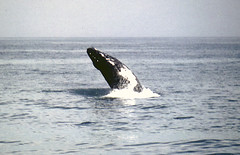
In between breaches, it would come to the surface and blow, then roll over on its back and "tail wag", flailing its fluke vigorously back and forth.
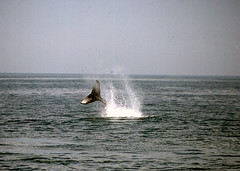
It looked "tiny" if you can call a 15' animal that. We were guessing it was a calf, but where was its mother?! We worried after seeing it alone for over ten minutes. To make matters worse, a fishing boat came steaming right across the little whale's path and we were frantic until we saw the it pop up again in boats wake and wheeze blow (a loud wheezing exhalation which is thought express alarm or annoyance). The whale went back to waving its flukes in the air as if nothing had happened and the people on the boat cheered in relief.
Well on the 20th of June a "close encounter" was exactly what we had! The day got off to a slow start... for the first hour and a half we watched a mature whale busily feeding. We stayed with it through 5 diving cycles: it would be down for 7 or 8 minutes, come up for 2 minutes and blow 6 to 9 times before diving again. The captain could see clumps of feed on the "feed finder" at about 310 feet below the surface.
After a while we were distracted by a finback who blew once and disappeared (they swim so fast, they can cover great distances under water) but it drew us further south and there we saw a whale breach twice!

In between breaches, it would come to the surface and blow, then roll over on its back and "tail wag", flailing its fluke vigorously back and forth.

It looked "tiny" if you can call a 15' animal that. We were guessing it was a calf, but where was its mother?! We worried after seeing it alone for over ten minutes. To make matters worse, a fishing boat came steaming right across the little whale's path and we were frantic until we saw the it pop up again in boats wake and wheeze blow (a loud wheezing exhalation which is thought express alarm or annoyance). The whale went back to waving its flukes in the air as if nothing had happened and the people on the boat cheered in relief.
1986 Second meeting with Talon 9/29/86 #3
We seemed to get Talon's attention when we started our engines to head for home. She dove, leaving her companion and came steaming over to us. Could it be she was tired of being whacked on the side by that big flipper? Or was she just distracted by the sound of the engine? I often wondered what our boat sounded like to the whales, and if they could distinguish it from other boats.
I had noticed these same scars on her back when we met her in June and wondered what could have caused them. There are very few sharp edges on a baleen whale; no teeth or claws. Most of the injury they might cause each other was with a powerful slamming tail or flipper, which would bruise not scratch. But there is a knob on the leading edge of the lower jaw of humpbacks and sometimes barnacles attach themselves to the protrusion. Perhaps another whale scraped her with this scratchy lump.

She did not make an effort to interact with us, just came breezing by quite close to us, giving us a good view of her identifying mark.
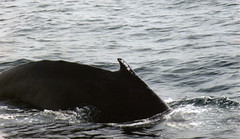
As we moved off she raised her tail high in a deep dive. When I looked back, back I saw that she had rejoined her companion.
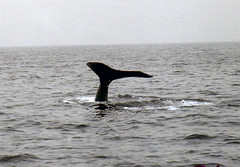
Soon she would be making the long trip to the Banks north of the Dominican Republic where Humpback whales go to mate and calve. They start arriving there in late December and it takes a month or two to complete the trip from the Gulf of Maine to the Caribbean, meaning they must leave the northern waters sometime in early November. Since they do very little feeding on their way down, while they are there and on their way back they need to build up their fat stores as much as they can during September and October.
Talon certainly looked energetic and healthy, perhaps she could afford leisure time to socialize. We went out for a couple more weeks, but didn't come upon her again that year. We saw her again the next June with her first calf and so realized that during these two 1986 sighting she had been pregnant!
I had noticed these same scars on her back when we met her in June and wondered what could have caused them. There are very few sharp edges on a baleen whale; no teeth or claws. Most of the injury they might cause each other was with a powerful slamming tail or flipper, which would bruise not scratch. But there is a knob on the leading edge of the lower jaw of humpbacks and sometimes barnacles attach themselves to the protrusion. Perhaps another whale scraped her with this scratchy lump.

She did not make an effort to interact with us, just came breezing by quite close to us, giving us a good view of her identifying mark.

As we moved off she raised her tail high in a deep dive. When I looked back, back I saw that she had rejoined her companion.

Soon she would be making the long trip to the Banks north of the Dominican Republic where Humpback whales go to mate and calve. They start arriving there in late December and it takes a month or two to complete the trip from the Gulf of Maine to the Caribbean, meaning they must leave the northern waters sometime in early November. Since they do very little feeding on their way down, while they are there and on their way back they need to build up their fat stores as much as they can during September and October.
Talon certainly looked energetic and healthy, perhaps she could afford leisure time to socialize. We went out for a couple more weeks, but didn't come upon her again that year. We saw her again the next June with her first calf and so realized that during these two 1986 sighting she had been pregnant!
1986 Second Meeting with Talon 9/29/86 #2
Talon and her companion came over briefly to check us. We were able to determine that this one was Talon because we saw her white dorsal mark just before she dove, but we couldn't find enough distinguishing features to identify the other. The differences between the two back tails were very subtle, but Talon's left fluke tip had a heavier concentrations of barnacles on it than did the other's. It was a distinctions that couldn't be counted on over time because barnacles build up and drop off in ever changing patterns, but it was just enough in combination with her white dorsal mark to help us separate these two black tails for this one encounter. Talon's character shown through as well: she showed a bit more interest in the boat, coming closer and hanging out a bit longer. The other hung back, waiting for her to rejoin it. In this picture Talon dives right in front of the boat, just beneath the bowsprit.
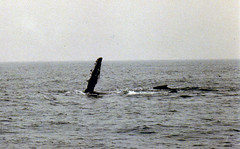
But Talon was obviously more interested in the other whale than she was in us and went back to flipper slapping, close and parallel to it. In this picture the mystery whale is lying on its side, its right flipper thwacking the water with a sharp report. You can see Talon's dorsal just beyond (click on the picture and you can see a larger version of this in flickr). Talon has just rejoined the mystery whale and is drifing slowly alongside while it slaps.
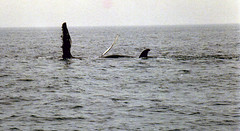
Slowly Talon rolled onto her left side, and started to raise her right flipper in the air. I was having a hard time making sense of all these whale parts sticking out of the water, but I think both whales had their backs facing our direction so the near whale's belly was facing Talon's back. I have tried to label them in the big photos at flickr (click on this picture)
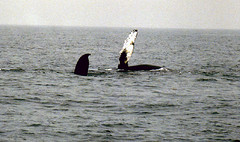
During our first meeting with Talon I got a close up photo of her flipper and it was white, so I am pretty certain this is hers raising up to thwack the water. Most of the time the two whales were hitting the water with their flipper. They would slowly raise all 15 feet of heavy muscle bone and flesh, suspend it for a moment wobbling high in the air then let it drop heavily with a smack and huge splash. Once the flipper of the mystery whale hit Talon's side. It made a dull thud and we could see her flesh jiggle. She didn't seem to mind, she didn't startle or move away, just continued to lay there slapping her flipper against the water.
They continued this behavior for 10 or 15 minutes, great, slow gestures over and over, rolling over on their bellies once in a while to breathe then rolling back again to whap the water again.

But Talon was obviously more interested in the other whale than she was in us and went back to flipper slapping, close and parallel to it. In this picture the mystery whale is lying on its side, its right flipper thwacking the water with a sharp report. You can see Talon's dorsal just beyond (click on the picture and you can see a larger version of this in flickr). Talon has just rejoined the mystery whale and is drifing slowly alongside while it slaps.

Slowly Talon rolled onto her left side, and started to raise her right flipper in the air. I was having a hard time making sense of all these whale parts sticking out of the water, but I think both whales had their backs facing our direction so the near whale's belly was facing Talon's back. I have tried to label them in the big photos at flickr (click on this picture)

During our first meeting with Talon I got a close up photo of her flipper and it was white, so I am pretty certain this is hers raising up to thwack the water. Most of the time the two whales were hitting the water with their flipper. They would slowly raise all 15 feet of heavy muscle bone and flesh, suspend it for a moment wobbling high in the air then let it drop heavily with a smack and huge splash. Once the flipper of the mystery whale hit Talon's side. It made a dull thud and we could see her flesh jiggle. She didn't seem to mind, she didn't startle or move away, just continued to lay there slapping her flipper against the water.
They continued this behavior for 10 or 15 minutes, great, slow gestures over and over, rolling over on their bellies once in a while to breathe then rolling back again to whap the water again.
1986 Second meeting with Talon 9/29/86 #1
It turned out Fissure and his companion were leading us towards two other whales who were breaching off in the distance, first one then the other. We wondered if Fissure was drawn by their breaching as much as we were. To us it was incredibly exciting to see these enormous beings fly out of the water and come smashing down again sending up an enormous spray. We wondered how Fissure experienced it under water, it must have made a pretty thunderous sound. Was he drawn towards them by their breaching? We totally lost track of Fissure in our excitement, there is nothing more about him in my notes.
As we got closer the breaching stopped and they began flipper slapping, lying close and parallel to each other, first one then the other. When we shut down the engines a few hundred yards away, they seemed to notice us and first one then the other rolled onto its belly and dove. Just before diving, the one on the right gave what is called a wheeze or trumpet blow, a forceful exhale that sounds a bit like someone blowing on a very big trumpet mouthpiece.
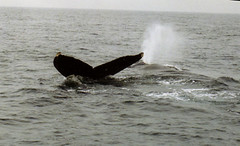
We could see they both had black tails making it very hard to tell which was which. It turns out that this one was Talon:
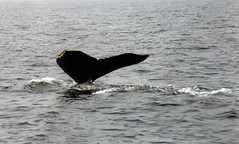
And this one was maybe FiveJ or who knows?
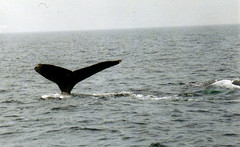
But the dorsals did help. Remember Talon had a white pattern on the right side of her dorsal? Unfortunately it didn't show very well when her left side was facing us, but her dorsal was clearly pointier than the other whales.

The other whale's dorsal has a very rounded tip in comparison. This whale looks small to me, so maybe it was a young one that wasn't in the catalogue yet
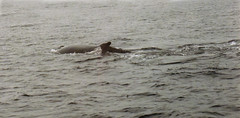
As we got closer the breaching stopped and they began flipper slapping, lying close and parallel to each other, first one then the other. When we shut down the engines a few hundred yards away, they seemed to notice us and first one then the other rolled onto its belly and dove. Just before diving, the one on the right gave what is called a wheeze or trumpet blow, a forceful exhale that sounds a bit like someone blowing on a very big trumpet mouthpiece.

We could see they both had black tails making it very hard to tell which was which. It turns out that this one was Talon:

And this one was maybe FiveJ or who knows?

But the dorsals did help. Remember Talon had a white pattern on the right side of her dorsal? Unfortunately it didn't show very well when her left side was facing us, but her dorsal was clearly pointier than the other whales.

The other whale's dorsal has a very rounded tip in comparison. This whale looks small to me, so maybe it was a young one that wasn't in the catalogue yet

1986 Second Meeting with Talon 9/29/86
By the end of September we were seeing a general movement to the south. Each day we would have to travel further down Jeffrey's ledge to find whales. On September 29th we had to go all the way down to Scantum's ledge (if you click on the map it will take you to a larger version with labels in flickr).

It was overcast that day. The air temperature was 61º and the sea temperature was down to 55º but there was no wind so it wasn't really cold. I came to treasure days with no winds and calm seas even more than sunny days since visibility would be ideal without the glare off the water.
As we traveled southeast across Jeffrey's basin, we encountered a lonely harbor porpoise then a blue shark, creatures that would be obscured if there was any chop. Finally, way south of where we usually went, we came upon two humpbacks who I say in my notes were just "breezing though", showing very little interest in interacting with our boat. One of them turned out to be our "friend" FISSURE!
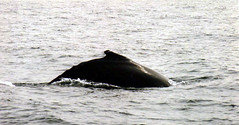
But he and his mystery companion were much more interested in each other than in us. In my notes I say they were "cruising" in sync rather than feeding. They would dive together remaining down for about 7 minutes and then come up to breathe for about 2 minutes, heading steadily westward. If they had been feeding we figured their movements would be more erratic and dives deeper (bringing up their flukes). You can see from this photograph why his companion remained a mystery...
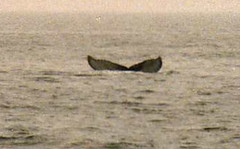
For every good fluke shot I took, at least 50 would come out like this... to far away and to blurry to match in the Humpback Catalogue. "Fluke matchers" try hard to find enough in these photos to indentify a whale but it is like squeezing water from a stone and we groan when these photographs come in. I've experienced it from both ends now... as a naturalist sending in these kinds of photos and now as a volunteer fluke matcher struggling with them, must be my karma!

It was overcast that day. The air temperature was 61º and the sea temperature was down to 55º but there was no wind so it wasn't really cold. I came to treasure days with no winds and calm seas even more than sunny days since visibility would be ideal without the glare off the water.
As we traveled southeast across Jeffrey's basin, we encountered a lonely harbor porpoise then a blue shark, creatures that would be obscured if there was any chop. Finally, way south of where we usually went, we came upon two humpbacks who I say in my notes were just "breezing though", showing very little interest in interacting with our boat. One of them turned out to be our "friend" FISSURE!

But he and his mystery companion were much more interested in each other than in us. In my notes I say they were "cruising" in sync rather than feeding. They would dive together remaining down for about 7 minutes and then come up to breathe for about 2 minutes, heading steadily westward. If they had been feeding we figured their movements would be more erratic and dives deeper (bringing up their flukes). You can see from this photograph why his companion remained a mystery...

For every good fluke shot I took, at least 50 would come out like this... to far away and to blurry to match in the Humpback Catalogue. "Fluke matchers" try hard to find enough in these photos to indentify a whale but it is like squeezing water from a stone and we groan when these photographs come in. I've experienced it from both ends now... as a naturalist sending in these kinds of photos and now as a volunteer fluke matcher struggling with them, must be my karma!
1986 First Meeting with Talon 7/9/86 #6
Talon spent the next half hour or so gliding from one position to another... spyhopping, rolling on her side and lifting one huge 15 foot flipper, holding it suspended then letting it fall with a thud like a big tree crashing to the ground. At one point she lay on her back and curled her fluke upwards bringing it down again and again with an exuberant splash. Luckily we were not on the receiving end!
It was all so flabbergasting and intimate that I finally just put down my camera and watched, recording as much as I could remember in my journal on the way home... sometimes a camera gets in my way... distancing me from the experience. But I did manage to get this picture of Talon sliding by almost close enough to touch, every texture, scar and depression so clear I can feel it. It was very hard to leave.
It was all so flabbergasting and intimate that I finally just put down my camera and watched, recording as much as I could remember in my journal on the way home... sometimes a camera gets in my way... distancing me from the experience. But I did manage to get this picture of Talon sliding by almost close enough to touch, every texture, scar and depression so clear I can feel it. It was very hard to leave.
Subscribe to:
Posts (Atom)
